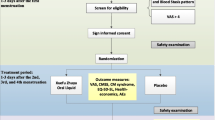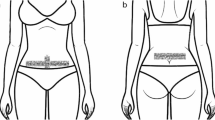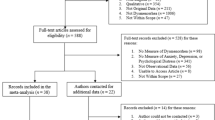Abstract
Purpose
Evaluating homeopathic treatment for dysmenorrhea.
Methods
Prospective multicenter observational study in primary care, using standardized questionnaires to record for 2 years diseases, quality of life, medical history, consultations, all treatments, other health services use.
Results
Fifty-seven physicians treated 128 women (age 32.4 ± 7.5 years, mean ± SD) and 11 girls (13.7 ± 4.0). Women had dysmenorrhea for 11.6 ± 9.0 (girls 3.1 ± 1.5) years. Patients received 7.5 ± 6.5 (5.9 ± 3.7) homeopathic prescriptions. Diagnoses and complaints severity improved markedly [at 24 months, dysmenorrhea relieved by > 50% of baseline rating in 46.1% (59) of the women and 45.5% (5) of the girls] with large effect sizes (24 months: Cohen’s d from 1.18 to 2.93). In addition, QoL improved (24 months: SF-36 physical component score: 0.25, mental component score 0.25, KINDL sum score 0.27). Conventional medication changed little and use of other health services decreased.
Conclusions
Patients with dysmenorrhea improved under homeopathic treatment. Controlled studies should investigate efficacy and effectiveness.
Similar content being viewed by others
Abbreviations
- WHO:
-
World Health Organization
- ICD:
-
International Classification of Diseases
- NRS:
-
Numerical rating scale
- QoL:
-
Health-related quality-of-life
- MOS SF-36:
-
Medical outcomes trust 36-item short form survey instrument
- KINDL:
-
KINDer Lebensqualitätsfragebogen
- Cn :
-
nth centesimal potency
- Qn :
-
nth quinquagintamillesimal potency
- GP:
-
General practitioner
- RCT:
-
Randomized controlled trial
References
Latthe PML, Say L, Gulmezoglu M, Khan KS (2006) WHO systematic review of prevalence of chronic pelvic pain: a neglected reproductive health morbidity. BMC Public Health 6:177
Proctor M, Farquhar C (2006) Diagnosis and management of dysmenorrhoea. Br Med J 332:1134–1138
Witt CM, Reinhold T, Brinkhaus B, Roll S, Jena S, Willich SN (2008) Acupuncture in patients with dysmenorrhea: a randomized study on clinical effectiveness and cost-effectiveness in usual care. Am J Obstet Gynecol 166:e161–e168
Ong CK, Bodeker G, Grundy C, Burford G, Shein K (2005) WHO Global Atlas of Traditional, Complementary and Alternative Medicine. World Health Organization. Centre for Health Development, Kobe
Eisenberg D, Davis R, Ettner S, Appel S, Wilkey S, Van Rompay M, Kessler R (1998) Trends in alternative medicine use in the United States, 1990–1997: results of a follow-up national survey. J Am Med Assoc 280:1569–1575
Härtel U, Volger E (2003) Inanspruchnahme und Akzeptanz von klassischen Naturheilverfahren und alternativen Heilmethoden in Deutschland: Ergebnisse einer repräsentativen Bevölkerungsstudie. Das Gesundheitswesen 65:A35
Beer A-M, Ostermann T (2003) On the use of classical naturopathy and complementary medicine procedures in hospitals and clinics practicing gynecology and obstetrics in Germany. Results of a questionnaire survey. Gynecol Obstet Invest 55:73–81
Ernst E (1998) Are highly dilute homoeopathic remedies placebos? Perfusion 11:291–292
Linde K, Clausius N, Ramirez G, Melchart D, Eitel F, Hedges L, Jonas W (1997) Are the effects of homoeopathy placebo effects? A meta-analysis of randomized, placebo controlled trials. Lancet 350:834–843
Shang A, Huwiler-Müntener K, Nartey L, Jüni P, Dörig S, Sterne JAC, Pewsner D, Egger M (2005) Are the clinical effects of homoeopathy placebo effects? Comparative study of placebo-controlled trials of homoeopathy and allopathy. Lancet 366:726–732
Becker-Witt C, Lüdtke R, Weißhuhn TER, Willich SN (2004) Diagnoses and treatment in homeopathic medical practice. Forsch Komplementärmed Klass Naturheilkd 11:98–103
Witt CM, Lüdtke R, Baur R, Willich S (2005) Homeopathic medical practice: long-term results of a cohort study with 3981 patients. BMC Public Health 5:115
Witt C, Lüdtke R, Willich SN (2005) Effect size in patients treated by homeopathy differs according to diagnosis—results of an observational study. Perfusion 18:356–360
World Health Organization (WHO) (2008) 2008 ICD-9-CM Diagnosis 625.3 [Dysmenorrhea]. Alkaline Software Inc, Fort Erie, Canada. http://www.icd9data.com/2007/Volume1/580-629/617-629/625/625.3.htm
Huskisson E, Scott J (1993) VAS Visuelle Analog-Skalen; VAPS Visual Analogue Pain Scales; NRS Numerische Rating-Skalen; Mod. Kategorialskalen. In: Westhoff G (ed) Handbuch psychosozialer Meßinstrumente – ein Kompendium für epidemiologische und klinische Forschung zu chronischer Krankheit. Hogrefe Göttingen, pp 881-885
Bullinger M, Kirchberger I (1998) SF-36 Fragebogen zum Gesundheitszustand—Handanweisung. Hogrefe, Göttingen
Bullinger M, von Mackensen S, Kirchberger I (1994) KINDL—ein Fragebogen zur Erfassung der gesundheitsbezogenen Lebensqualität von Kindern. Zeitschrift für Gesundheitspsychologie:64–70
Ravens-Sieberer U, Bullinger M (1998) Assessing health-related quality of life in chronically ill children with the German KINDL: first psychometric and content analytical results. Qual Life Res 7:399–407
Rubin DB (1987) Multiple imputations for nonresponse in surveys. Wiley, New York
Diggle P, Liang K, Zeger S (1994) Analysis of longitudinal data. Clarendon Press, Oxford
Mee R, Chua T (1991) Regression toward the mean and the paired sample t test. Am Stat 45:39–42
Marstedt G, Moebus S (2002) Gesundheitsberichtserstattung des Bundes—Inanspruchnahme alternativer Methoden in der Medizin. Robert Koch Institut, Berlin
Hoffmann S (2007) Diagnosespektrum in homöopathischen Arztpraxen – eine prospektive Beobachtungsstudie und ein Vergleich zu konventionellen Arztpraxen. Medizinische Fakultät, vol Dr med. Charité, Universitätsmedizin Berlin, Berlin
Anelli M, Scheepers L, Sermeus G, Van Wassenhoven MH (2002) Homeopathy and health related quality of life: a survey in six European countries. Homeopathy 91:18–21
Fortes L, Fraiz IC (2002) Homoeopathy from the patient’s standpoint: an empirical study in the City of Curitiba (Brazil), 1998–1999. In: Dinges M (ed) Patients in the history of homoeopathy. European Association for the History of Medicine and Health Publications, Sheffield, pp 301–316
Jacobs J, Chapman E, Crothers D (1998) Patient characteristics and practice patterns of physicians using homeopathy. Arch Fam Med 7:537–540
Kerek-Bodden H, Koch H, Brenner G, Flatten G (2000) Diagnosespektrum und Behandlungsaufwand des allgemeinärztlichen Patientenklientels. Ergebnisse des ADT-Panels des Zentralinstituts für die kassenärztliche Versorgung. Z Ärztl Fortbild Qualitätssich 94:21–30
Spence DS, Thompson EA, Barron SJ (2005) Homeopathic treatment for chronic disease: a 6-year, University–Hospital outpatient observational study. J Altern Complement Med 11:793–798
Sharples F, van Haselen R (1998) Patients perspective on using a complementary medicine approach to their health: a survey at the Royal London Homoeopathic Hospital. NHS Trust
Jain A (2003) Does homeopathy reduce the cost of conventional drug prescribing? A study of comparative prescribing costs in General Practice. Homeopathy 92:71–76
Van Wassenhoven M, Ives G (2004) An observational study of patients receiving homeopathic treatment. Homeopathy 93:3–11
Deveugele M, Derese A, van den Brink-Muinen A, Bensingand J, De Maeseneer J (2002) Consultation length in general practice: cross sectional study in six European countries. Br Med J 325:472–477
Bahrs O (2003) Mein Hausarzt hat Zeit für mich—Wunsch und Wirklichkeit. GGW 1:17–23
Ravens-Sieberer U, Bullinger M (2007) KINDLR Homepage : Revised Children Quality of Life—Questionnaire. vol 2007. http://www.kindl.org/indexE.html
Barnett AG, Van der Pols JC, Dobson AJ (2005) Regression to the mean: what it is and how to deal with it. Int J Epidemiol 34:215–220
Schantz M (2005) Klassisch-Homöopathische Therapie bei Endometriose. AHZ 250:117–126
Hunton M (1993) Endometriosis and homoeopathy. An audit study of 8 consecutive patients. Br Hom J 82:92–96
Gerhard I, Schantz M, Sillem M, Runnebaum B (1998) Homöopathische Behandlung der Endometriose. Arch Gynecol Obstet 261(suppl 1):181
Schmück M, Gerhard I, Lüdtke R, Seidenabel P (1995) Behandlung von Zyklusstörungen mit Homöopathie und die Problematik des Wirksamkeitsnachweises mittels einer randomisierten placebokontrollierten Doppelblindstudie. EHK 44:556–562
Lüdtke R, Schmück M, Gerhard I (1997) Methodische Überlegungen zum Wirksamkeitsnachweis der homöopathischen Einzelmittelbehandlung von Zyklusstörungen. Forsch Komplementärmed 4:28–32
Yakir M, Kreitler S, Brzezinski A, Vithoulkas G, Oberbaum M, Bentwich Z (2001) Effects of homeopathic treatment in women with premenstrual syndrome: a pilot study. Br Hom J 90:148–153
Acknowledgments
We want to thank the participating physicians for their work and the patients for their cooperation. We thank Elvira Krüger for data acquisition and to Karin Weber and Katja Wruck for data management. This work was supported with a grant by the Karl und Veronica Carstens-Foundation, D-Essen, for SNW and CMW.
Conflict of interest statement
None.
Author information
Authors and Affiliations
Corresponding author
Rights and permissions
About this article
Cite this article
Witt, C.M., Lüdtke, R. & Willich, S.N. Homeopathic treatment of patients with dysmenorrhea: a prospective observational study with 2 years follow-up. Arch Gynecol Obstet 280, 603–611 (2009). https://doi.org/10.1007/s00404-009-0988-1
Received:
Accepted:
Published:
Issue Date:
DOI: https://doi.org/10.1007/s00404-009-0988-1




